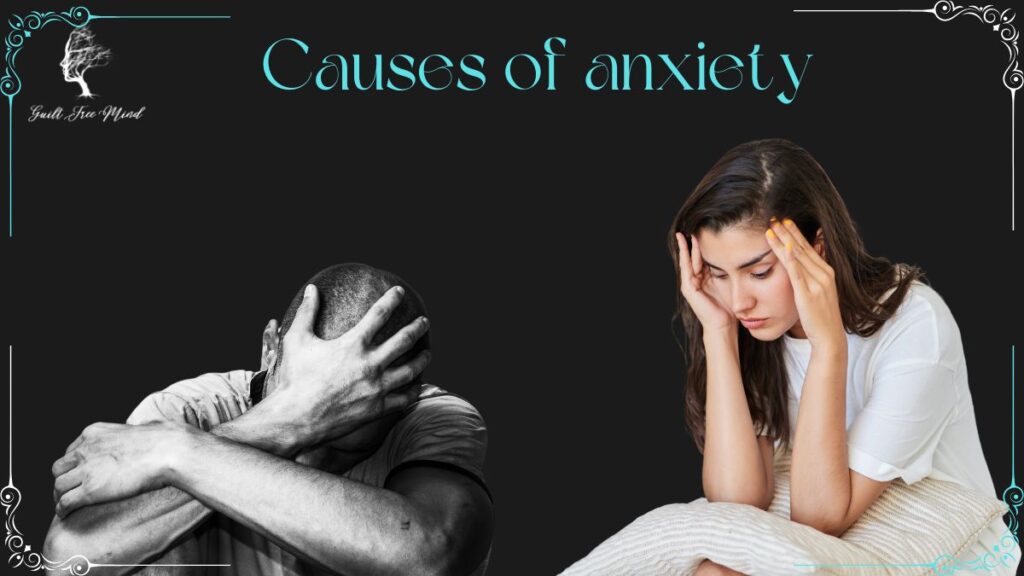There are millions of people all around the world that suffer from anxiety. Feelings of anxiety, worry, and unease remain on a daily basis, interfering with a person’s ability to function normally. Even though you may feel anxious from time to time, crippling levels of anxiety are not. In order to effectively treat anxiety disorders and provide appropriate assistance to those who are suffering from them, it is essential to understand the underlying causes of anxiety.
The first and foremost thing to know is that anxiety stems from various factors, some of which may be unique to each individual. They involve many different aspects, both internal and external. Understanding why certain people are more prone to having anxiety disorders than others can be achieved by investigating these aspects. In this blog post, I will discuss the different factors that may contribute to someone being more anxious than others. If you want to know what lies behind anxiety, then keep reading all the way till the end.
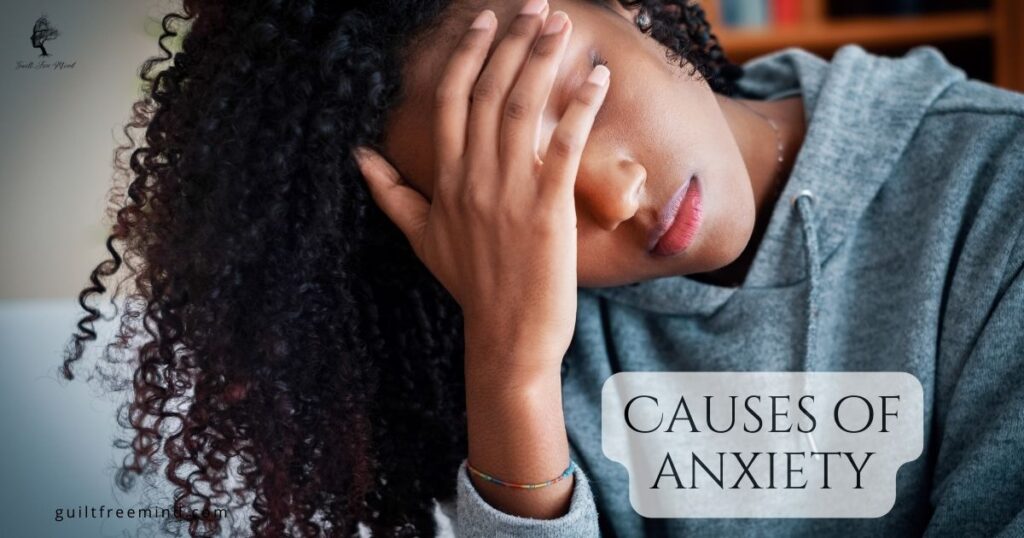
If you wish to know more about how to lead a positive and mindful life, subscribe to the Guilt Free Mind blog. The subscription option is present in the sidebar. Your subscription will allow me to notify you about all the new blog releases pertaining to leading a more positive life. If you like watching videos, subscribe to the YouTube channel of Guilt Free Mind. Ensure that you ring the notification bell and set it to ALL. This way YouTube will not miss out on notifying you about new video releases.
Table of Contents
Understanding your causes of anxiety is crucial.
There are several reasons why it’s crucial to figure out what triggers one’s anxiety. Uncovering the causes of anxiety disorders allows us to do the following:
Diagnosis and treatment
Diagnosis and treatment of anxiety can be improved by first determining the underlying causes of the disorder. Medical personnel can better serve their patients by meeting their specific requirements if they understand the origins of their anxiety. Last but not least, it allows for the best therapeutic or pharmaceutical interventions to be chosen in order to address root causes and symptoms.
Allows for better prevention
The authorized bodies can improve current efforts at prevention by learning more about the factors that contribute to the development of anxiety. By identifying the causes of anxiety, we can take steps to lessen the possibility that a person will acquire an anxiety disorder from an early stage. This could include offering workshops on stress management or early intervention programs in schools for children at risk because of their genetics or the environment they are being brought up in.
Encourage Introspection and Adaptive Behaviors
Anxiety sufferers benefit from developing an understanding of the factors that contribute to their condition. Through this comprehension, they are better able to identify their own weaknesses, triggers, and patterns. When people are armed with this information, they are better able to create healthy coping mechanisms and make decisions that benefit their mental health. Individuals can take charge of their health by implementing self-care strategies including stress management and regular tweaks.
Be able to help others
By learning more about what triggers anxiety, we can better understand others who suffer from it and hence have more compassion for them. It encourages understanding that anxiety disorders are multifaceted problems affected by a wide range of causes, rather than simple manifestations of a lack of willpower or character faults. You will be able to better help others if you have this information. People with anxiety disorders will find it easier to seek care and make progress toward recovery if society as a whole is more empathic and compassionate.
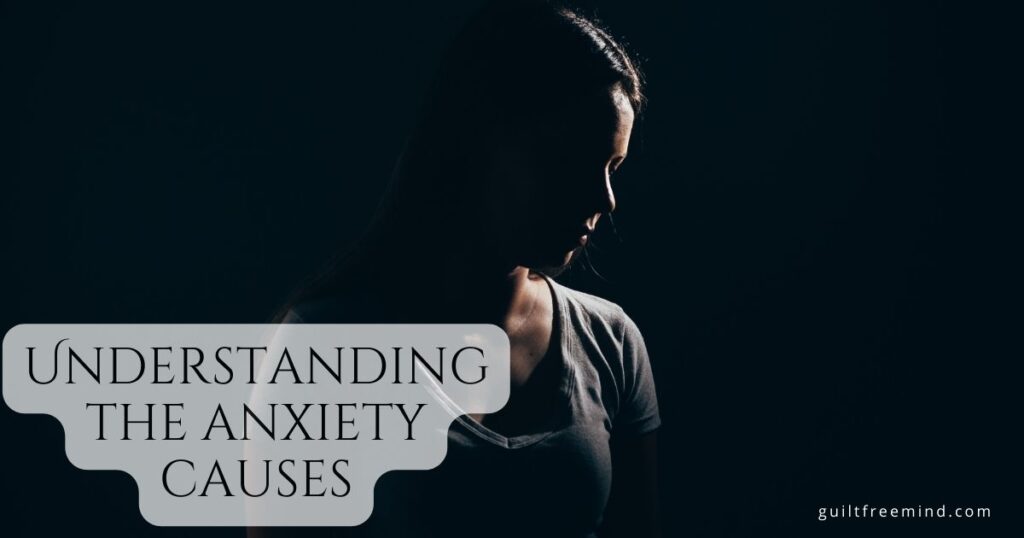
Facilitate Research and Development
Continuing research and development in the field of mental health are fueled by a deeper understanding of the causes of anxiety. Based on the identified causes, researchers can investigate novel therapy modalities, pharmaceutical therapies, and preventative strategies. It promotes teamwork among professionals from different fields to increase our understanding of anxiety and come up with novel strategies for treating and managing it.
The Role of Biological Factors in Anxiety
Anxiety disorders are largely influenced by biological causes. Understanding the biological foundations of anxiety is helpful because it sheds light on the crucial interactions of various factors that can lead to anxiety. Key biological components that can act as causes of anxiety are as follows:
Genetic manifestation
According to studies, anxiety disorders appear to have a genetic propensity. This may be influenced by family history. Anxiety tends to run in families, so those who have a history of family members or relatives suffering from anxiety are more likely to have it themselves. Certain genes involved in neurotransmitter modulation, including serotonin and dopamine, have been linked to anxiety disorders. It’s vital to remember that environmental influences along with heredity can shape an individual’s susceptibility to anxiety.
Neurotransmitters imbalance
Imbalances in the brain’s neurotransmitters can cause a wide range of negative emotions and altered mental states. Anxiety has been linked to a disruption in the equilibrium of some neurotransmitters, including serotonin, gamma-aminobutyric acid (GABA), and norepinephrine. Serotonin, also known as the “feel-good” neurotransmitter, aids in mood regulation, whereas GABA dampens overactive nerve cells. Anxiety symptoms may be exacerbated if there is dysregulation in neurotransmitter conduction or production.
Differences in brain structure
Neuroimaging research has shown that people with anxiety disorders do not all have the same brain structure or level of brain activity. Anxious people frequently have amygdala hyperactivity, which plays a significant role in the regulation of emotional and fearful reactions. Anxiety disorders have also been linked to changes in the prefrontal cortex, the area of the brain that controls executive processes and emotion regulation.
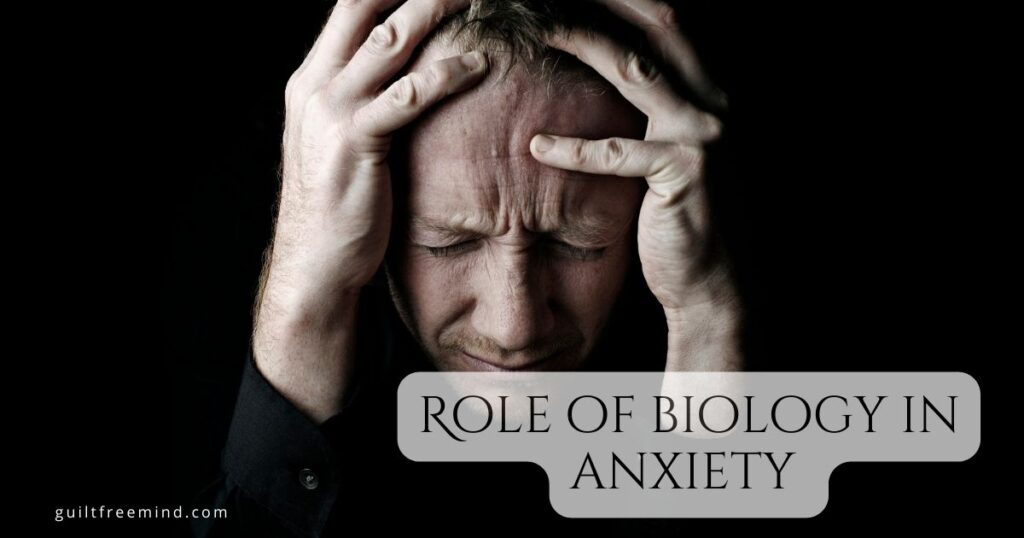
Problems in the HPA axis
The hypothalamic-pituitary-adrenal (HPA) axis is a highly intricate neuroendocrine system responsible for controlling the body’s stress response. If there is an inadequate functioning of this axis, it can lead to anxiety. Studies have shown that the HPA axis may be dysregulated in anxious people, resulting in a reaction toward stress that is different from normal individuals. This can lead to an increase in the production of the stress hormone cortisol, which in turn may exacerbate anxiety.
Hormonal factors
Anxiety levels, particularly in women, can be affected by hormonal factors, such as estrogen and progesterone abnormalities. Increased susceptibility to anxiety symptoms may result from the fluctuating hormone levels that occur during the menstrual cycle, pregnancy, postpartum, and menopause.
While these biological elements have been linked to anxiety, they certainly aren’t the only ones at play. Anxiety disorders have multiple contributing elements, including biological, environmental, psychological, and social aspects, all of which interact with one another. In the following section, I will discuss how the environment can serve as the cause of anxiety.
Causes of Anxiety Related to the Environment
The environment is a major contributor to the emergence of anxiety disorders. Anxiety can be caused or made worse by a number of different things, both internal and external. Key environmental elements that have been linked to anxiety include:
Repressed childhood trauma
Repressed childhood experiences can have enduring impacts on an adult’s mental health. These events include trauma, physical, emotional, or sexual abuse, neglect, or unstable home circumstances. Experiencing such trauma in childhood may increase a child’s risk of acquiring anxiety problems as an adult.
Constantly living in a stressful situation
Anxiety can be exacerbated by prolonged exposure to stressful situations, like difficulties in workplace, at school, or in personal relationships. The overproduction of stress hormones and susceptibility to anxiety symptoms are results of the body’s stress response system being activated by chronic stress.
Sudden changes
Stressful life experiences or substantial shifts may initiate or amplify an anxiety disorder. Divorce, the death of a loved one, a move, a new career, or college all qualify as life-altering events. Such sudden changes can threaten a person’s sense of safety and security. This can lead to an increase in worry which in turn will increase anxiety.
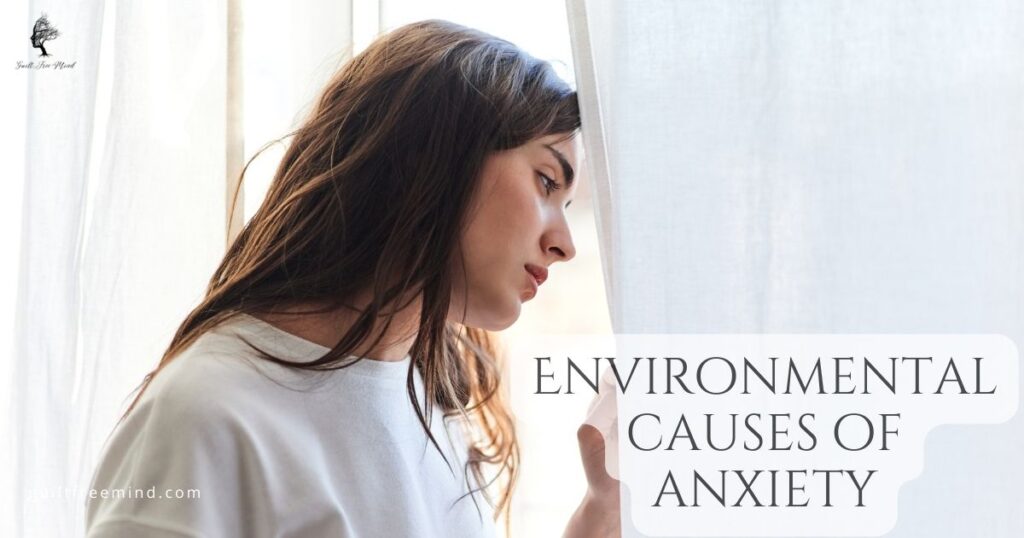
Substance abuse
Anxiety disorders can be exacerbated by the use and misuse of substances such as alcohol, narcotics, and even some prescription prescriptions. Substance abuse has been shown to induce anxiety by altering the brain’s chemistry. As a matter of fact, anxiety is a common withdrawal symptom, and it can also be caused by withdrawing from substances to which the body has become physically addicted.
Social issue
Environmental variables can play a role in the development and maintenance of social anxiety disorder, which is characterized by an irrational fear of being judged or negatively evaluated by other people. Furthermore, environmental cues such as crowds, noises, or circumstances might elicit anxiety reactions in those who are vulnerable.
Negative parenting styles
Anxiety in children may be affected by the parenting style and examples set by their parents. Young toddlers can internalize the anxiety of their parents or other caretakers if they observe them exhibiting nervous behaviors or being overprotective. Anxiety can develop for a variety of reasons, including being raised in a setting where excessive worry is encouraged or where independence is discouraged.
Psychological causes of anxiety
Anxiety disorders have a strong psychological component that contributes to both their onset and persistence. Anxiety can be attributed in part to one’s way of thinking, feeling, and behaving. The following are some of the most important psychological causes of anxiety:
Faulty cognitive habits
Catastrophizing, or exaggerating the frequency and severity of adverse events, overgeneralizing, or making broad negative conclusions based on limited experiences, and selective attention to threat cues are all common cognitive patterns identified in anxiety disorders. Persistent anxiety can be exacerbated by mental practices such as critical self-talk, excessive concern, and ruminating.
Perfectionist behavior
Anxious people frequently display characteristics of perfectionism and high levels of worry. They could have unrealistically high expectations of themselves and suffer from crippling anxiety whenever they stray from those ideals. Anxiety symptoms might be exacerbated by the persistent pressure to achieve impossible goals.
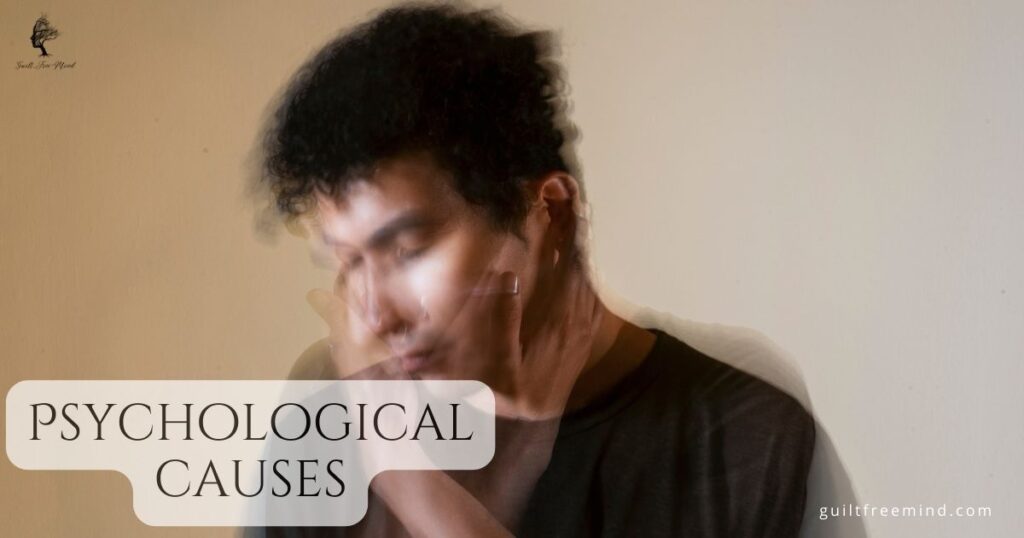
Control issues
Anxiety might result from wanting too much control or knowing too little, both of which are unrealistic. Anxious people may experience a worsening of their symptoms in the face of uncertainty. This is because of their inability to cope with ambiguity. They might over-plan, constantly seek reassurance, or try to avoid scary situations.
Traumatic past
The development of PTSD and other anxiety disorders has been linked to other issues. These can be exposure to traumatic events, such as physical assault, serious accidents, or witnessing violent acts. The mere thought of a terrible occurrence might affect a person’s sense of security and bring on severe anxiety.
Personality traits
Anxiety disorders are more common in people with particular personality features. Anxiety is linked to personality traits including introversion, lack of initiative, and high neuroticism (the propensity to feel negative emotions). These characteristics can affect how a person reacts to stressful events, making them more prone to anxiety.
Learned behavior
Anxiety is a learned behavior that can be conditioned into one’s life. Individuals may develop conditioned reactions and identify certain triggers with anxiety. This will happen in case they have previously experienced anxiety or dread in similar situations or in response to similar stimuli. Anxiety symptoms may persist due to these learned associations.
Negative self-image
Anxiety disorders are strongly linked to low self-esteem, a negative self-image, and harsh self-criticism. Anxiety symptoms can be exacerbated in those with poor self-esteem because they worry more, dread failure more, and are more sensitive to criticism and rejection.
Social and Cultural Root Causes of anxiety disorders
The onset and manifestation of anxiety disorders are greatly impacted by social and cultural variables. These include things like one’s community, cultural norms, and societal expectations, all of which can have a role in the development, maintenance, or worsening of anxiety symptoms. Some important cultural and social influences on anxiety are as follows:
Social issues
Social anxiety occurs when a person is in a persistent worry state over receiving unfavorable opinions from others in social circumstances. Cultural and societal norms, like the value put on outward appearance, achievement, or compliance, may have a role in the emergence of social phobia. These anxiety symptoms can become worse of societal pressures to follow the norms, embarrassment, or rejection by others.
Social Support and peer influence
Anxiety levels may be affected by one’s social circle, which includes both friends and acquaintances. Anxiety is common in children and adolescents and can get heightened by negative peer pressures such as bullying or being left out of activities done by friends. Positive social assistance from friends, family, or support groups, on the other hand, can act as a buffer, easing the burden of anxiety and bolstering the individual’s capacity to bounce back from setbacks.
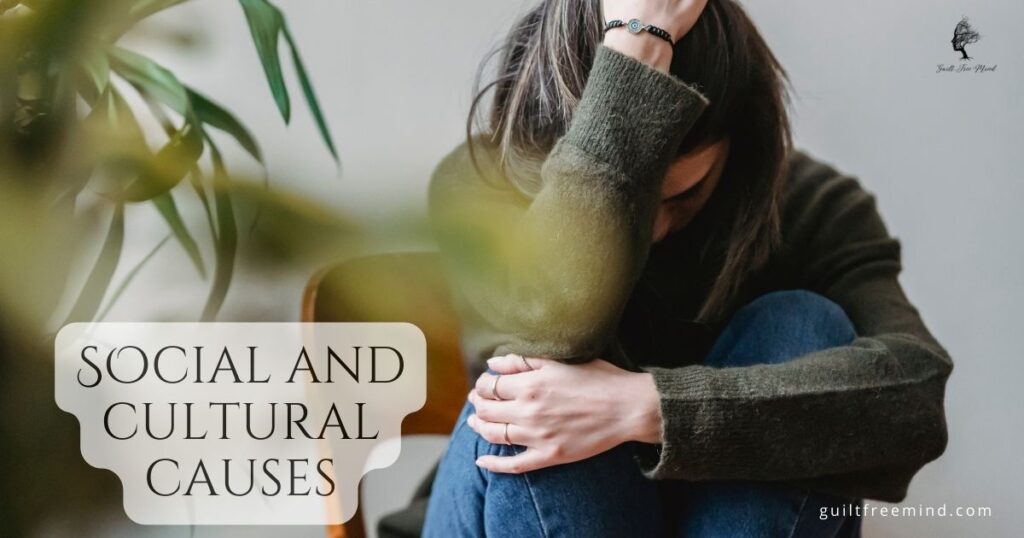
Cultural norms
Cultural norms and societal expectations impact people’s perspectives on the world and their daily lifestyles. Anxiety can increase due to the constant social demands that people face. These can be from their education, work, relationships, and marriage. Anxiety symptoms are more common in those who believe they are not living up to the preset cultural norms that place heavy importance on accomplishment, competition, or unbending rules about gender.
Discrimination
Anxiety is just one of many mental health conditions that can be negatively impacted by discrimination and marginalization due to variables such as
- race
- ethnicity
- gender identity
- sexual orientation
- disability
If a person is living in an environment that promotes toxicity, discrimination and excludes the person from participation, it can lead to increased anxiety.
Technology and social media
Even though the advancements in technology have made our lives much easier, media and technology also contribute to anxiety. Anxiety symptoms may be aggravated by things like
- social media comparisons
- cyberbullying
- watching people display perfect figures and face on Instagram
- too much screen time
Anxiety can be triggered by the media’s unrealistic portrayals of success, or social relationships by making people feel inadequate or causing them to live in constant fear of missing out (FOMO).
Upbringing and family dynamic issues
Anxiety might have roots in a person’s upbringing and the dynamics of their family. It can get exacerbated by factors such as an overprotective or controlling parenting style, harsh criticism, or a complete lack of emotional support from family members. Furthermore, it can be influenced by factors such as a family history of anxiety disorders or faulty coping mechanisms within the family unit.
Cultural influence
There is already severe mental health stigma and prejudice in our society regarding mental illness can have a real-world effect on people’s anxiety levels. Anxiety sufferers may be less likely to seek help or communicate openly about their symptoms if they come from a culture that stigmatizes or trivializes mental health issues.
Conclusion
There is no single explanation for anxiety disorders. Instead, such issues result from a combination of elements across biological, environmental, psychological, and social/cultural domains. The effective diagnosis, treatment, prevention, and support of individuals with anxiety depend on a thorough understanding of these reasons.
Biologically speaking, anxiety disorders are associated with genetic predispositions, neurotransmitter imbalances, brain structure and function, hormonal variables, and HPA axis instability. Adverse childhood experiences, chronic stress, life events, substance addiction, social triggers, and parental influences are a few of the environmental elements that contribute.
Anxiety disorders have multiple psychological causes, including thought patterns, perfectionism, concern, uncertainty phobia, trauma, personality traits, and taught behaviors. Another important thing that you must remember is that anxiety is also influenced by social and cultural variables such as fear of social situations, peer pressure, discrimination, the media, family dynamics, and general beliefs about the importance of treating mental health issues seriously.
Individualized interventions and treatments for anxiety can be developed in response to the recognition and understanding of the wide range of potential causes. This aids in correct diagnosis, the creation of efficient treatment regimens, and the provision of preventative care. In addition, those who suffer from anxiety disorders will benefit from a more accepting society with less stigma, higher levels of empathy, and a more comforting atmosphere is created.
Finally, last but not least, if you want access to the blog posts the moment they release, subscribe to Guilt Free Mind. The subscription option is present in the side bar. If you like watching videos, subscribe to the YT channel of Guilt Free Mind. Ensure that you ring the notification bell and set it to ALL so that YouTube notifies you the moment the next video releases.
See you in my next blog post
Frequently Asked Questions
-Biological (genetics, brain chemistry)
-Environmental (stressful life experiences, trauma)
-Psychological (cognitive processes, personality traits)
-Social/cultural (social pressures, cultural expectations)
variables are all possible contributors to anxiety.
Anxiety problems do seem to have a hereditary component. It is more likely to occur if there is a history of the disorder in the family or a close relative who suffers from it. This disorder is not entirely predetermined by genes. Environmental variables also play a major role.
Yes, traumatic events like physical or emotional abuse, accidents, or witnessing violence can increase a person’s risk of developing anxiety disorders like PTSD.
Increased vulnerability to anxiety has been linked to a number of personality qualities. This includes strong neuroticism (the tendency to experience negative emotions), introversion, and an inhibited temperament. But personality is just one of several factors that might lead to worry.
Yes, of course! Anxiety can be profoundly affected by social variables including peer pressure, prejudice, or cultural expectations. Fear of being judged or negatively evaluated by other people is a major component of social anxiety disorder.
Yes, prolonged or extreme stress can aggravate preexisting anxiety. Furthermore, the stress response system activation and disruption of neurotransmitter balance enhances susceptibility to anxiety when chronic stress is present for long time.
One of the long-term consequences on mental health and an increased chance of developing anxiety disorders have been linked to adversities experienced in childhood, such as trauma, abuse, neglect, or unstable home settings.
